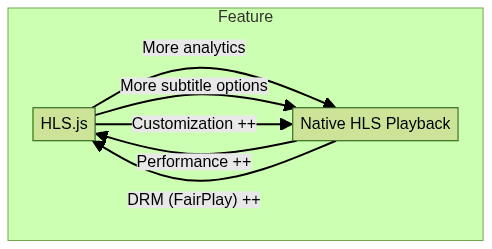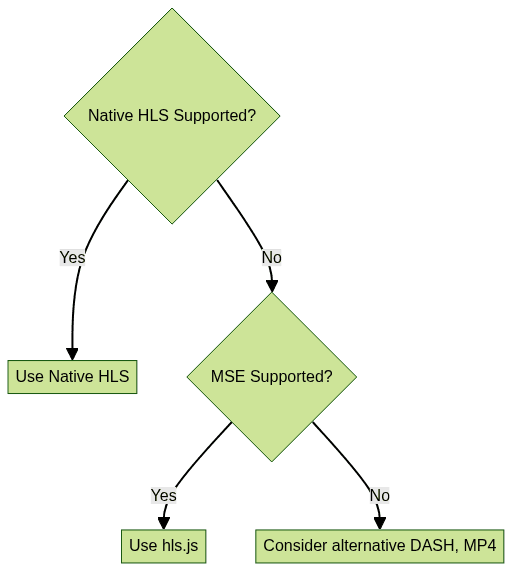Introduction to Native HLS Playback
Native HLS playback has become a cornerstone of modern video delivery on the web. HTTP
Live Streaming
(HLS) is Apple’s adaptive streaming protocol, widely used for delivering live and on-demand video at scale. When we talk about native HLS playback, we refer to the ability of a browser or device to play.m3u8 HLS streams directly via the HTML5 <video> element, without needing any additional JavaScript libraries or browser plugins.As video consumption on the web grows in 2025, understanding native HLS support is crucial for developers. It affects not only user experience and performance but also impacts security, device compatibility, and development complexity. Let’s dive into what native HLS playback really means, its browser support, how to implement it, and best practices for optimal streaming solutions.
What is Native HLS Playback?
HTTP
Live Streaming
(HLS) is a protocol developed by Apple for streaming media over the internet. HLS works by breaking video into small, HTTP-based file segments, described by an.m3u8 playlist. The player downloads and plays these segments in real time, allowing for adaptive bitrate switching and resilient playback over variable networks.Native HLS playback means the browser or device can interpret
.m3u8 files and decode HLS streams directly using its built-in media engine. This is typically achieved through the HTML5 <video> element, and does not require JavaScript libraries like hls.js or video.js, nor browser plugins (e.g., Flash, Silverlight).If you're building interactive applications, you might also want to explore integrating a
javascript video and audio calling sdk
to enable real-time communication features alongside your streaming content.Key differences from plugin or JS-based playback:
- Native: Uses the browser’s or OS’s media stack; no third-party code required.
- JS-based (e.g., hls.js): Uses JavaScript to parse HLS playlists and segments, feeds them into the browser via Media Source Extensions (MSE).
- Plugin-based: Relies on external software, now deprecated for security and compatibility reasons.
Native HLS playback offers lower latency, better battery efficiency (especially on mobile), and tighter OS integration—but with tradeoffs in feature set and cross-browser support.
Browser Support for Native HLS Playback
Native HLS playback is not universally supported across all browsers. Here’s a 2025 compatibility snapshot:

Browser Support Matrix
| Browser | Native HLS Playback |
|---|---|
| Safari (macOS) | ✅ Supported |
| Safari (iOS/iPadOS) | ✅ Supported |
| Chrome (desktop) | ❌ Not Supported |
| Firefox | ❌ Not Supported |
| Edge | ❌ Not Supported |
| Android Chrome | ⚠️ Device-dependent |
| Samsung Internet | ⚠️ Partial |
- Why limited support? Apple’s HLS stack is proprietary, and most browsers use third-party media engines (not WebKit). Chrome, Firefox, and Edge rely on Media Source Extensions (MSE), which do not natively support HLS.
If you're developing for mobile platforms, especially Android, you may want to learn more about
webrtc android
to enable real-time communications and streaming capabilities on those devices.Detecting Native HLS Playback in JavaScript
To build robust apps, you must detect native HLS support and provide fallbacks. Here’s how:
1function canPlayNativeHLS() {
2 const video = document.createElement("video");
3 return (
4 video.canPlayType("application/vnd.apple.mpegurl") ||
5 video.canPlayType("application/x-mpegURL")
6 );
7}
8
9if (canPlayNativeHLS()) {
10 // Use native HLS playback
11} else {
12 // Fallback to JS-based solution like hls.js
13}
14Implementing Native HLS Playback in Your Web Projects
Native HLS playback is simple where supported. Here’s a basic implementation using the HTML5
<video> element:1<video
2 controls
3 width="640"
4 height="360"
5 src="https://example.com/stream.m3u8">
6Your browser does not support the video tag.
7</video>
8How it works: If the browser/device supports native HLS, it will fetch and play the
.m3u8 stream directly. Otherwise, playback will fail unless you provide a fallback.For those building cross-platform apps, consider leveraging
flutter webrtc
to add real-time video and audio features to your Flutter projects, complementing your streaming solutions.Fallback Strategies: hls.js and video.js
Most developers use JavaScript libraries like
hls.js
orvideo.js
to enable HLS playback on browsers without native support (e.g., Chrome, Firefox). These libraries parse.m3u8 manifests and segments in JavaScript, then use the Media Source Extensions (MSE) API to feed data to the browser’s media engine.If you're looking to quickly integrate video communication, you can
embed video calling sdk
solutions into your web projects for seamless setup and deployment.Example: Fallback to hls.js
1const video = document.getElementById("video");
2const hlsUrl = "https://example.com/stream.m3u8";
3
4if (video.canPlayType("application/vnd.apple.mpegurl")) {
5 video.src = hlsUrl;
6} else if (Hls.isSupported()) {
7 const hls = new Hls();
8 hls.loadSource(hlsUrl);
9 hls.attachMedia(video);
10} else {
11 // Handle unsupported case
12}
13When to use which?
- Use native HLS playback where possible (Safari, iOS). It’s more efficient and better integrated.
- Use hls.js or similar for Chrome, Firefox, Edge, and most Android browsers.
- Consider
MDN: HTML5 video element
andApple Developer: HTTP Live Streaming Overview
.
If you're working with React Native, integrating a
react native video and audio calling sdk
can help you add robust real-time communication features alongside your video streaming components.Advantages and Limitations of Native HLS Playback
Advantages
- Performance: Uses device-optimized decoders, lower CPU/battery use
- Simplicity: No third-party JS bundles
- Security: Full support for platform DRM (e.g., Apple FairPlay)
- Tighter OS integration: System-level controls, AirPlay, Picture-in-Picture
If you need to add conferencing features to your streaming app, consider using a
Video Calling API
to enable high-quality video and audio calls across platforms.Limitations
- Feature gaps: Limited analytics hooks, ad insertion, subtitle/customization support
- Inconsistent implementation: Varies by OS/browser version
- No support on most desktop browsers except Safari
- Less control: Harder to patch or extend behavior compared to JS-based players

Troubleshooting Native HLS Playback
Native HLS playback is reliable on supported platforms, but you may encounter issues such as:
- .m3u8 not playing: Check MIME type (
application/vnd.apple.mpegurl), ensure no typos in URL. - Codec support: Browser/device must support video/audio codecs used in your stream (e.g., H.264/AAC).
- CORS errors: HLS playlists and segments must be served with appropriate CORS headers.
- DRM issues: FairPlay or EME errors if using encrypted streams.
For developers seeking to integrate real-time communication with their streaming solutions, a
Video Calling API
can streamline the process and enhance user engagement.Debugging tips:
- Use browser developer tools (Network, Console tabs)
- Check
W3C Media Source Extensions spec
- Try playback on multiple devices/browsers to compare behavior
Best Practices for Native HLS Playback
- Cross-browser compatibility: Always detect native HLS support, and provide JS-based fallbacks.
- Responsive design: Make your
<video>player flexible for mobile/desktop screens. - Accessibility: Use captions/subtitles (
<track>element), provide alternative audio where possible.
1<video controls width="100%" height="auto" src="https://example.com/stream.m3u8">
2 <track kind="captions" src="captions_en.vtt" srclang="en" label="English">
3 Your browser does not support the video tag.
4</video>
5- Testing: Regularly test on Safari, iOS, and fallback devices.
- Security: Ensure proper CORS, encryption, and DRM where required.
If you're interested in experiencing these features firsthand,
Try it for free
and see how easy it is to implement modern video streaming and communication solutions.Conclusion: Is Native HLS Playback Right for You?
Native HLS playback provides the most efficient and seamless video streaming experience where supported, especially on Apple platforms. However, due to limited browser support, most web projects require a hybrid strategy—native where available, JavaScript-based fallback elsewhere.

By understanding the strengths and constraints of native HLS playback, you’ll deliver robust, high-performance video experiences across all platforms in 2025.
Want to level-up your learning? Subscribe now
Subscribe to our newsletter for more tech based insights
FAQ